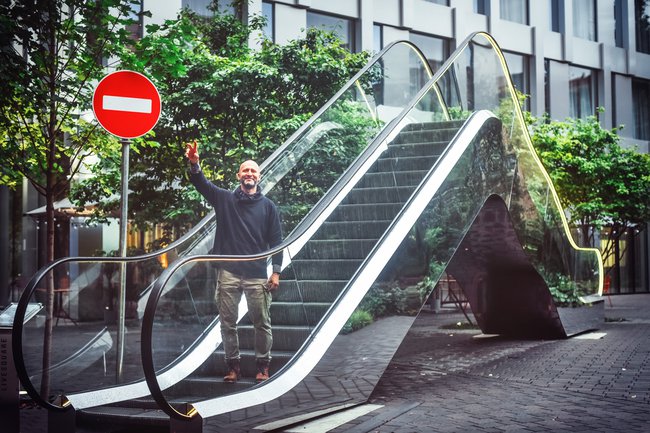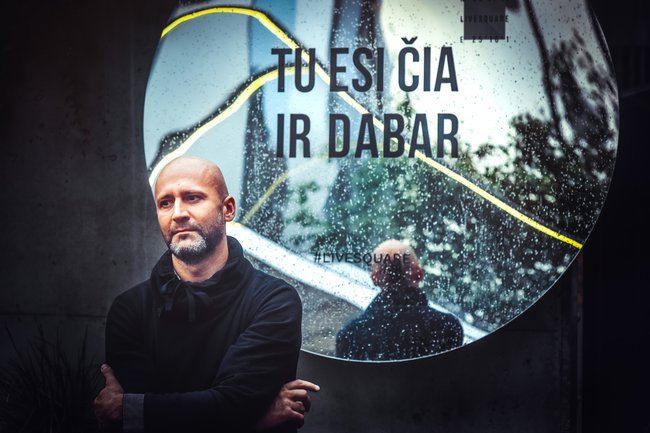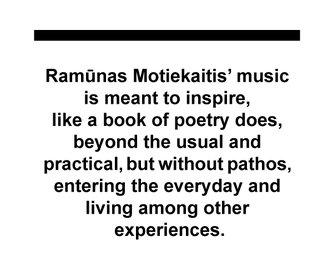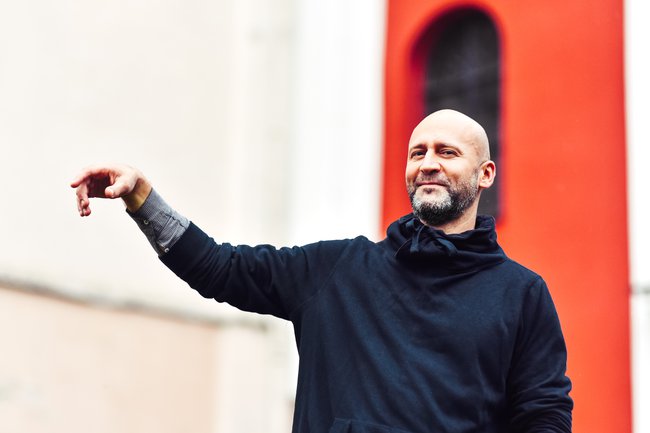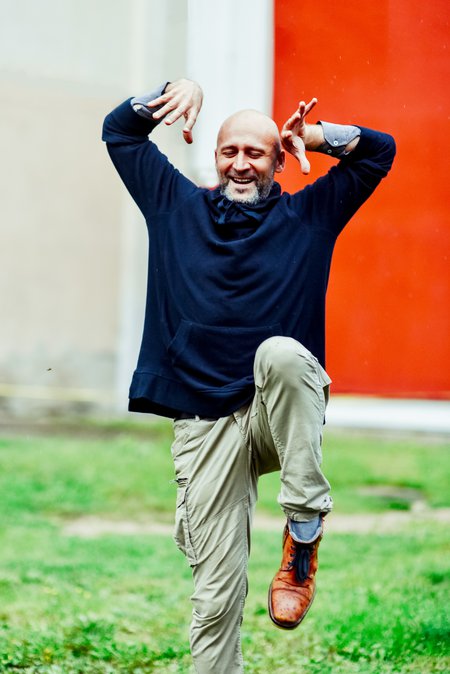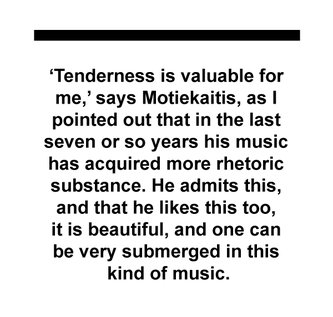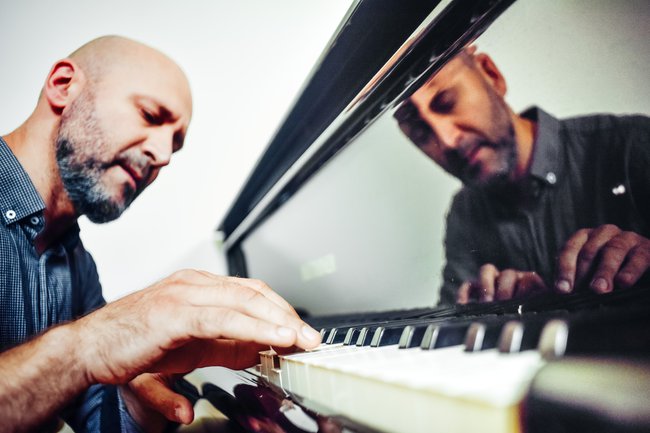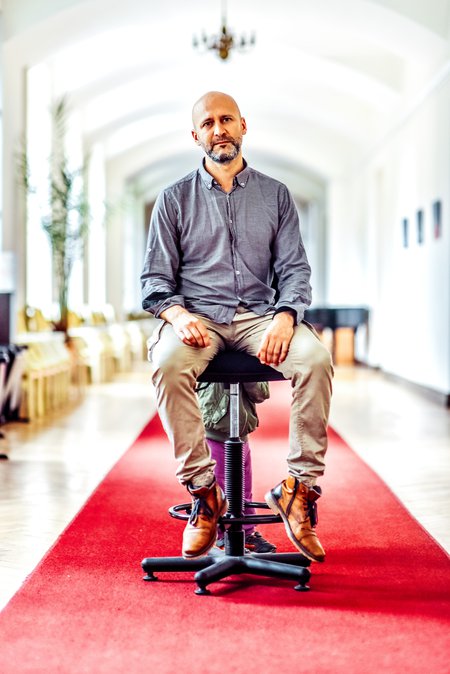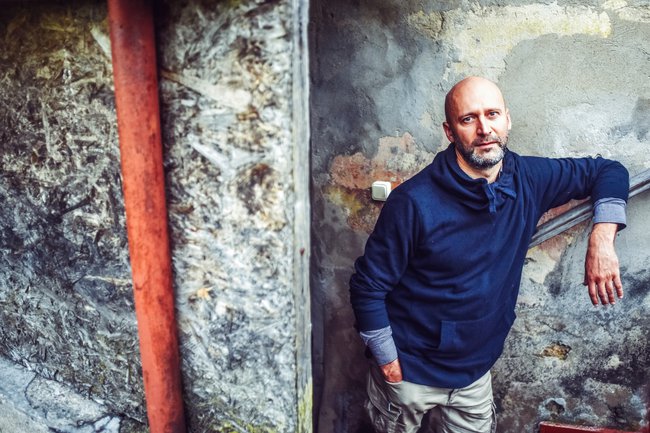Edvardas ŠUMILA | The Pursuit of Balance: The Soothing Rhetoric of Ramūnas Motiekaitis’ Music
The music of Ramūnas Motiekaitis (b. 1976) is saturated with ambivalence and seeks to find its path to the listener by avoiding being the centre of attention. This music is surrounded by tensions, which pertain to questioning the justification of its existence, the balance between its communicative force and subtleness, between distance and openness. The distance is reflected in Ramūnas' own way of living; he lives quite outside of Vilnius, in a house surrounded by a forest, a house which he himself rebuilt in one year. When we met to talk, Ramūnas confessed that the situation had been difficult for him in the past few days, as he was writing his new work: ‘It seems so futile to undertake such a thing as to write a piece of music, which will get performed only once and without the right effort and nuance, it is then put away and sits, without anyone caring to pick it up again.’ Even when you understand that art music is something that is not essentially meant to be widely popular in general, it seems hard to take up and do things that might be meaningful just to yourself. And this is the struggle that Ramūnas admits undergoing each time he tries to reconnect with his creative process. And because of knowing him well, I think that this ambivalence is something that Ramūnas couldn't do without. It is reflected in his composition process as much as in its result, that is weighed on the, I must say, dialectics between fighting your demons, daring to speak something through your music and yet trying not to explicate too much, to resist melodramatic or overly excessive gestures.
I am pretty sure that what I have outlined above is at the heart of Ramūnas Motiekaitis' creative oeuvre. Hence, we could say that the recurring pressure to bid farewell to music and composition every time is the condition for it to exist; it is the constant shudder of experience when you doubt everything and wonder if it is worth undertaking. Yet you come back to it. Is it possible to create something without wanting it to be heard and recognised, and I mean this not in the sense of status, but as something familiar and longed for? This is, I believe, what is in part another motivation of Ramūnas' work; and this comes with the strong notion that the appeal is anticipated to be to the few, who in these times seek something very peculiarly resistant to both – the established and popular – and at the same time to what is opposed to it, something ‘alternative,’ something ‘cool and rebellious,’ which, at the end of the day, is just the flip-side of the same coin, and is subsumed under the same interest.
One can never achieve this completely, and this is arduous because you must search and linger, admitting eventually that it didn't happen. But the strength lies in this short glimpse of the belief and the satisfaction given by the process itself. According to Ramūnas, if one is to retain an aesthetic sensibility, it is possible to act only in a particular circle of listeners. While one would want more support within that particular group of people, the music itself has features that might not seem very affective and needed at first glance, so the relationship is complicated.However, it does not at all seem that Ramūnas’ music is neglected. It has often been lauded over the years, commissioned and played by the best performers in Lithuania. Nor could one say that his music is alienating or impossible to listen to, or that it lacks interest from performers or audiences. I had the experience of organising a retrospective of Ramūnas' electronic works in the AHEAD festival back in 2015; the festival is chamber-like and does not attract massive audiences, yet just word of this concert attracted a big crowd of composers, many of whom never show up to other festival events. So, there is a need and a demand for his music.
And similarly, last year, his early works – parts of his Mobile cycle (started back in 1996) – were remembered by Arturas Bumšteinas, the director of the Jauna Muzika festival, and chosen to be performed at its final concert, which appealed to a fairly large audience, as it was a great musical experience and affirmation of the path that Motiekaitis undertook from the onset of his creative output. The cycle remains one of the most vivid examples of his uniqueness, very much sustained, some of it created as acousmatic electronic pieces, playing with synthesizers, employing sinusoidal wave timbres. Among other things, this lets the composer avoid the expressiveness of a performer, something that has always bothered or concerned Ramūnas. Although it's been a while since Motiekaitis created electronic works, it is an important part of his creative output in general. His nine-minute piece I Can’t Get Through to You (2013), consisting of different pitch-less sounds, put together in a quasi-pointillistic manner but almost without traditional musical parameters, except perhaps rhythm and duration. Indeed, not only doesn't it get through to you by means of these knocking sounds, nor does it knock you out with intrusiveness – it arouses a different kind of interest in a way invoking a Cageian way of listening. We often talk about the tone of progress that was in the background from the onset of 19th-century aesthetics and has prevailed in many ways until today. And it may seem that if one does not show progress and innovation it is a path to marginalisation. And yet, Ramūnas' work proves that one can achieve meaningfulness through something that was done two decades ago, and I am referring to the same Mobile concert of 2019. I asked Ramūnas how his aesthetic attitude developed, as music by so many people is often viewed through the mythologised notion of art, in an exalted manner. He admitted that he would like to look at it in this way even now, but on the one hand, composition becomes a craft, and the habits and skills take priority over the more radical impulses, while on the other – there is always an urge to do something that won't just gratify the expectations of the performers and listeners. And then, there is little space for that kind of romanticist outlook.However, there was a longing for something different from what was composed at the time when Ramūnas took up composition. As a young student, Ramūnas attended the Darmstadt Summer Course in 1998, along with Žibuoklė Martinaitytė, Raminta Šerkšnytė, and Vytautas V. Jurgutis. I asked if anything significant had struck him. He admitted that it seemed to him that all the music performed there, three times a day for more than two weeks, was obsolete and uninteresting, stuffed with extended techniques but without any particular direction. Performers were labouring through that music, where something is happening in the dense scores – nobody was sure what. But it was the same festival at which he heard a gagaku orchestra for the first time, and that was something completely different from the experience in that context. This is how I see Ramūnas' music in the buzz of everydayness, something withheld from explicit expression and yet standing out with its serenity, aware of other possibilities, in search of them.
During the following years, Ramūnas' experience was extended a good deal more, he studied composition at the Norwegian Academy of Music in Olso (Norges musikkhøgskole) and acquired a Ph.D. in Musicology at the University of Helsinki, and also spent three years at different research institutions in Japan such as the Nanzan Institute for Religion and Culture. He has often travelled to China and Japan for his research projects or commissions. It has been noted that Ramūnas Motiekaitis' music has seen changes in development, and that was one of my starting points when I thought about how I would articulate his compositional milieu. And the truth is that it seems Ramūnas is fonder of his early work, while the pieces with more traditional teleology, clearer climax points and more defined harmonies are just the compromises he made in the tense moments of balancing aesthetic distance with expectations and anticipated reception. Nevertheless, they are never too explicit and should not be viewed as such. There are other influences that inspire that kind of music. If a score must be more detailed and challenging for the performer – as in his piece Light on Light (2005) for trombone and string quartet, it still retains Ramūnas' attitude and is marked with attention to nuance, similar to the works of Tōru Takemitsu, one of the composers admired by Ramūnas, and a rare occurrence on the Lithuanian music scene, probably because of the same demands on detail.
Among other things, voice is something that has a special place for Ramūnas. Something which one does not find very easily in his works – there are only a few composed for choir or voice. He was a choir boy in the boys’ and youth choir Ąžuoliukas, and later a member of Aidija, a well-known Lithuanian choir. As he puts it, a choir is a somewhat different organism than an orchestra or a solo instrument. Despite that there are monumental pieces in their repertoire, much of it is chamber choir music or music from the Renaissance. This organic musicianship, singing as one, almost by heart, neutralises the attack the instruments have, and voice can barely come close to it. This can be seen explicitly in Motiekaitis’ Symphonie de Septembre (2009) for full choir, setting to music the words of Oscar Milosz, a Lithuanian poet who wrote in French. It reveals this sensibility and the close relation of music and text – giving the possibility to do what is more difficult with an instrumental setting, to make the motifs interwoven, be close to each other and at the same time gentle and self-sufficient.One of the pieces in his Mobile cycle, particularly Mobile-8 (1997), which at the last concert was performed on water cooler bottles and conducted by Ramūnas himself, was originally conceived for choir as well. As was another less known piece Counterparts and Me, written in 2000, the first year of his MA studies, and using many of the texts he was reading at the time, stitching them together in static verticals with only viola harmonics, piano chords and subtle percussion accompanying them.
‘Tenderness is valuable for me,’ says Motiekaitis, as I pointed out that in the last seven or so years his music has acquired more rhetoric substance. He admits this, and that he likes this too, it is beautiful, and one can be very submerged in this kind of music, although he thinks there will be less and less of this kind of expression in his music in the future. I'd like to note the value of self-reference in the music that was composed in this period, especially one of the last pieces he wrote, called Cinema (2019) for chamber orchestra, commissioned by the Vilnius Festival. Throughout our friendship, we've talked a lot about film, and it is not the most favourable art form in Ramūnas' eyes, he is often critical and that's because he thinks it to be intrusive and manipulative, perhaps too explicit and straightforward. By having this in mind I think there is a slight self-ironical gesture in calling the piece Cinema, which is one of the most lyrically expressive throughout his oeuvre. But that said, it's not so simple; we watched classics of Lithuanian film together, particularly those by Algimantas Puipa and Arūnas Žebriūnas, Ramūnas is also a huge fan of Yasujirō Ozu’s films and is well versed in their language. A self-aware composer, especially one who is also scholarly inclined, is condemned to question his relation to tradition, and especially to romanticism and modernism. And if the category which prevails after both of them is the sublime, then Ramūnas chooses his version of the sublime to be the fragile, the delicate, the intimate, certainly without the drama and egocentrism. Many of his works of the past several years have been more conventional in their form. The chords just come on the paper, and yet they are cryptic and meaningful in an indirect way.This cryptic quality is something which gives power to the pieces like that, where harmonies are never sure, their telos is something in between, or rather contains both. It is somewhat similar to the rhetoric gestures from the music around the 17th century, where affects are complex and have different polarities joined together. The music can swiftly change its shadings, lighting, and attitude, exhibiting this as a complex whole, where one has never to choose neither triumph nor resignation. The prudent phrases just evaporate into silence. All these traits are especially inherent in Motiekaitis’ Nocturne (1997), The Music of Silent Things (1999), Intermezzo/Cinema (2007), Equinoxes (2007) and the above-mentioned Mobile-8.
His creative stance also pertains to his music as a whole – on a macro level: as much as there is always the tension and balance between more open language and sustained ambivalence in the compositional process, there are dialogues between the pieces themselves, which sometimes get closer to the personal, and then bounce back to distance. Among those pieces we could say are No Blood... No Wings (2014) and Katabasis (2018). Interestingly, all these pieces have similar semi-large instrumentation, a string orchestra, or as in the last case, strings, piano, and clarinet, which hint at a relation between instrumentation and means of expression. However, some of the older pieces, e.g. Insect Steps (2011), commissioned for symphonic orchestra by the Gaida festival, is much less explicit, more sustained in its texture, and much more Feldmanesque and introverted.
I have to acknowledge that Ramūnas and his stance as a scholar and an artist have been quite influential on my own path. He taught the aesthetics course which I took as a piano performance student a decade ago, and that led me to understand culture as multilayered and with a certain depth that was hard to find anywhere else in my curriculum at the time. His aesthetic attitude struck me as being highly resistant to the façade of culture, where everything seems to be measured by popular significance. I believe anyone who wants to delve deeper into the works of Ramūnas should not ignore his scholarly, philosophical and musicological side, and especially his monograph Poetics of the Nameless Middle: Japan and the West in Philosophy and Music of the Twentieth Century (2011), based on his dissertation, which I reread after a long time, and was no less astonished at its depth and insight. Perhaps I should not mingle the two sides of his work, but the Middle, as a capacious metaphor, extends to what was said about his music.Nevertheless, according to Ramūnas Motiekaitis, the condition which occurs when losing oneself in creation does not really leave space for reflection, it has to be set aside and comes back only unconsciously. And essentially, his music is meant to inspire, like a book of poetry does, beyond the usual and practical, but without pathos, entering the everyday and living among other experiences.
English text edited by Romas Kinka
